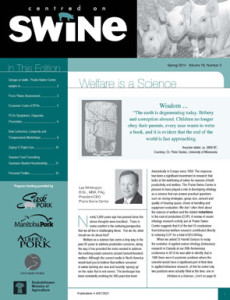Group Sow Housing – the Facts
Posted in: Pork Insight Articles, Production by admin on March 27, 2014 | No Comments
When converting to group sow housing it is important that the environment provides good animal welfare, animal performance is maintained, and the transition is economically successful. The EU and four states have banned gestation stalls, and many retailers are pressuring producers to make plans to go stall free. Denmark and the Netherlands have both achieved high sow performance with group housing, and with proper management sow performance can be maintained except for a potential dip immediately after the transition. There are various systems available, and the four major points to consider when choosing a system are floor space allowance, feeding strategies, group mixing plans, and stockpeoples’ capabilities. Providing opportunities for sows to flee or avoid dominant sows can allow the group hierarchy to become established with less aggression and injuries. As well, using mixing strategies such as a mixing pen; sorting by size, parity, BCS, and gestational stage; and adding larger groups into a dynamic group can help reduce aggression. Temperament assessments may also help to form groups that will have less aggression. There are space guidelines for group housing, but actual space allowance should be based on behaviour, group size, and other pen features. The layout of the pen can be considered as the quality of space. There should be natural spaces for certain activities, and the layout should allow for walking and lying naturally. Space quality can be improved with dividers, environmental enrichment or bedding, and flooring type, as fully slatted floors can increase the incidences of lameness. In group housing, the stockpeople become more important for how well the system will work for production levels and sow wellbeing, and good, daily animal observations should be made. Overall, more research is needed to determine the optimum system for sow welfare and production, although the EU process of transitioning can offer valuable insights.
Positioned for Success
Posted in: Economics, Pork Insight Articles by admin on | No Comments
2006-2013 supplied many financial challenges to producers, but cautious optimism is beginning to show for 2014. The past problems included a high Canadian dollar, high grain prices due to biofuel and ethanol, COOL laws, health challenges, Canadian pork packer problems, and reduced global demands from recessions. Short-term optimism is due to lower feed costs, higher hog prices, and a weaker Canadian dollar. Long-term optimism is due to the fact that Canada is a well-established exporter of pork, and can take advantage of the expected increased global demand. Canada also has the land, resources, herd health status, and technology availability to continue to be competitive in the global market.
Investigation of the use of meloxicam for reducing pain associated with castration and tail docking and improving performance in piglets
Posted in: Pork Insight Articles, Welfare by admin on March 12, 2014 | No Comments
Animal welfare concerns and public opinion are bringing focus onto the pain involved in piglet processing procedures, and the possibility of using analgesics for pain management. Pain control has not been widely used by producers because of the economic and practicality problems in administering one. This study looked at the effect of meloxicam (a NSAID) on growth, mortality, and pain control. 30 minutes before tail docking and castration (in males) 0.4mg/kg of meloxicam was given to half of the piglets, and a placebo given to the other half. Pain was measured by recording vocalization, observing behaviour in a sample litter for 30 minutes after processing, and recording cortisol levels at 30, 60, 90 minutes, and 4 hours post-processing. Growth was measured by weighing at processing, and again at weaning. Mortalities, litter size, and sow parity were also recorded. There was no significant difference in maximum vocalization amplitude between meloxicam or placebo groups during processing. From behavioural observations, the only significant difference was a decrease in isolation behaviour in the meloxicam group. Other pain related behaviours differed between treatment and sex. Baseline cortisol levels varied, did not have a normal distribution, and were higher in males. Cortisol levels increased during processing, and decreased by 49.4 nmol/L (P=0.06) after 60 to 90 minutes post-processing. The meloxicam treated group had lower cortisol levels by 49.4 nmol/L (P<0.001) after controlling for time and gender.Meloxicam did not have a statistically significant affect on the overall growth or mortality; although, it was found that litters of sows with parities greater than 5 did have reduced mortality. Overall, meloxicam had no effect on growth rate, mortality rate, or pain control during processing procedures when measured by vocalization. It did, however, provide pain control following processing when measured by cortisol levels and behavioral observations.
Centred on Swine Volume 19
Posted in: Pork Insight Articles, Prairie Swine Centre by admin on March 6, 2014 | No Comments
Individual articles in these issues of Centred on Swine are located in our PorkInsight Database.
- Minimizing & Managing Ingredients Variability
- Effectiveness of Sprinkling During Transport
- Novel Biocontainment Concept for Quarantine Facilities
- Nutritional management of grow-finish pigs: energy and feed efficiencyn
- Feeding Fusarium Contaminated Grain
- Groups or stalls: Prairie Swine Centre weighs in
- Force Plates Assessment
- Economic Costs of PEDv
- PEDv Symptoms, Diagnosis, Prevention
- Sow Lameness, Longevity and Temperament Workshops
- Zephyr-E Piglet Gun
- Gowans Feed Consulting Graduate Student Assistantship
Mucosal Bacteria Associated with Periods of Reduced and Compensatory Growth in Pigs
Posted in: Pork Insight Articles, Production by admin on January 29, 2014 | No Comments
Reduced diet quality or the removal of antibiotics in starter diets has no overall effect on growth performance to market, but it may affect the ileal bacterial profile. Nursery pigs were fed either a high or low quality protein source, and with or without chlorotetracycline. Bacterial profiles were more affected by the week of nursery than by diet. Pigs fed the low quality diet had an increase in Clostridium paraputrificum between nursery week 2 and 8, and Clostridium leptum decreased. The proportion of Sarcina genus bacteria declined in low quality diets, but increased in high quality diets. Overall, this suggests an increase in beneficial bacteria and decrease in potentially pathogenic bacteria in pigs fed low quality diets, which may help to explain the compensatory growth these pigs experience post-nursery.
Patterns of Nitrogen Retention in Gestating Gilts
Posted in: Nutrition, Pork Insight Articles by admin on | No Comments
This study examined the patterns of nitrogen retention in gestating sows, and protein deposition with varying energy intake. Sows were fed 15% above or 15% below recommended energy intake, and N-balance was determined five times during gestation. Protein deposition was significantly higher when energy intake was higher, as stated in NRC (2012), but protein deposition levels were lower than predicted by NRC. By accurately determining nutritional requirements throughout gestation, sow needs can be more accurately met and costs saved by reducing nutrient loss.
Non-Protein Nitrogen is Used Efficiently for Improving Protein Deposition and Feed Efficiency in Growing Pigs
Posted in: Nutrition, Pork Insight Articles by admin on | No Comments
The balance between amino acids and nitrogen is important to consider when formulating diets. When diets are low in nitrogen non-essential amino acids are also lowered, and the nitrogen needed to produce non-essential amino acids to build muscle protein will come from other amino acids in excess, or from non-protein nitrogen. This study tested the supplementation of ammonium salts to provide non-protein nitrogen when non-essential amino acids were limited, as would occur in a low protein diet. Increasing amounts of non-protein nitrogen increased feed efficiency compared to a low protein negative control, decreased feed intake, and did not affect weight gain.
Impact of Nursery Diet Quality and Fish Oil Supplementation on Growth Performance of Pigs
Posted in: Nutrition, Pork Insight Articles by admin on | No Comments
Feeding lower complexity starter diets has been shown to have no effect on overall growth performance, but may affect immune response and growth during a disease challenge. This study tested the effect of adding fish or corn oil to low or high complexity diets on immune function. In early phases, the low protein diet had lower ADG, ADFI, and Gain:Feed. Fish oil had treatments showed no difference in ADG, tended to have lower ADFI, and had a significantly better Gain:Feed. The increased Gain:Feed with fish oil may suggest some improvement in immune response.
Research Update: Enrichment Devices for Nursery and Grow-Finisher Pigs
Posted in: Pork Insight Articles, Welfare by admin on | No Comments
Enrichment devices are now required in the Canadian Code of Practice for the Care and Handling of Pigs, but there is not a clear choice for a durable, safe, and sanitary toy that keeps pig interest. The first part of this study tested pig interest in a teeter-totter or rooting style toy. The teeter-totter was more popular, but pigs showed interest in both toys until the end of the study at four months. The next part compared teeter-totter to a tri-star hanging toy. The tri-star had more pigs playing with it, but was also more destructible – which may be part of the increased interest. The effect of noise was also examined with the attachment of a bell, and the bell resulted in no change in pig interest. The final part of the study will determine if all pigs play with the toy, or if only certain ones play repeatedly.
Improving Soybean Meal Nutrient Value via Fermentation Using Newly Isolated Bacteria
Posted in: Nutrition, Pork Insight Articles by admin on | No Comments
Piglet gastrointestinal tracts are still developing and unable to digest large proteins, like glycinin which is found in soybean meal. Bacterial fermentation of soybean meal prior to feeding shows positive results for digestibility in weaned pigs, and this study tests novel strains of bacteria for the fermentation. Bacteria isolates from fermented foods were tested for high enzymatic activity, then used to ferment soybean meal, and the total soluble protein was measured. 10 bacteria had high enzymatic food, and had varying success at increasing nutritional value.











